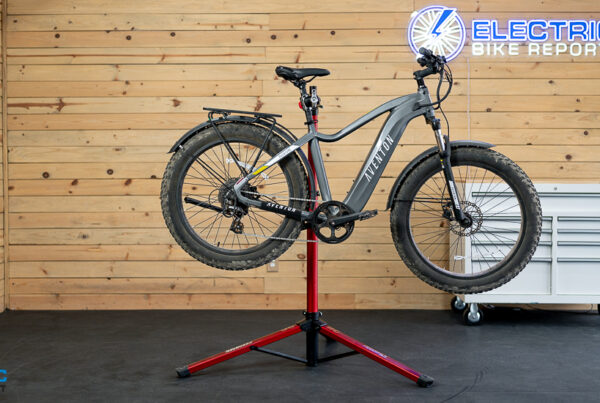An e-bike’s ride quality is often determined by personal preference, but here at Electric Bike Reportwe do our best to remain objective. I found the Super73 S2 to be fun and generally comfortable to ride, easy to operate, and appropriately responsive, but let’s examine the elements that contributed to that interpretation more closely.
As with most of the moped-style e-bikes we have reviewed, the S2’s saddle is a long, padded seat with a stationary position, so its height of 31” is fixed. We liked that the saddle was narrower toward the front, which made the riding position feel natural. The 680mm riser bars include straight, aggressively textured rubber grips. These were easy to hold on to, and placed our hands at a comfortable and ergonomic angle.
As a hardtail e-bike, bumps and dips were noticeable but not uncomfortable. We’d have preferred a slightly thicker saddle, but we appreciated the damping effects of the squishy air suspension fork with its substantial 140mm of travel.
The S2 comes in a single size which Super73 advertises as appropriate for riders from 5’-1” to 6’-8”. Our testers, who are generally around 6’ tall, were comfortable, but we could imagine that the bike would feel more cramped for those on the taller end of the advertised range.
Overall, the bike handled well due to its short wheelbase, which gave it a playful, spirited feel. With a dual-crown suspension fork, the bike’s handlebars were limited in their ability to turn, which resulted in a relatively wide turning radius, though this was helped by the maneuverability of the small 20” Super73-branded BDGR moped tires.
The S2’s 750W motor was engaged quickly by its cadence sensor; pedal assistance was activated with between a ⅛- to ¼-turn of the cranks, with gradually-building power and speed. The bike’s throttle power was similar – we appreciated that it wasn’t too punchy. Riders seeking more immediate power should be satisfied with the feel of PAS 4.
.
.
.
#Super73 #Review #Electric #Bike #Report
Source link








